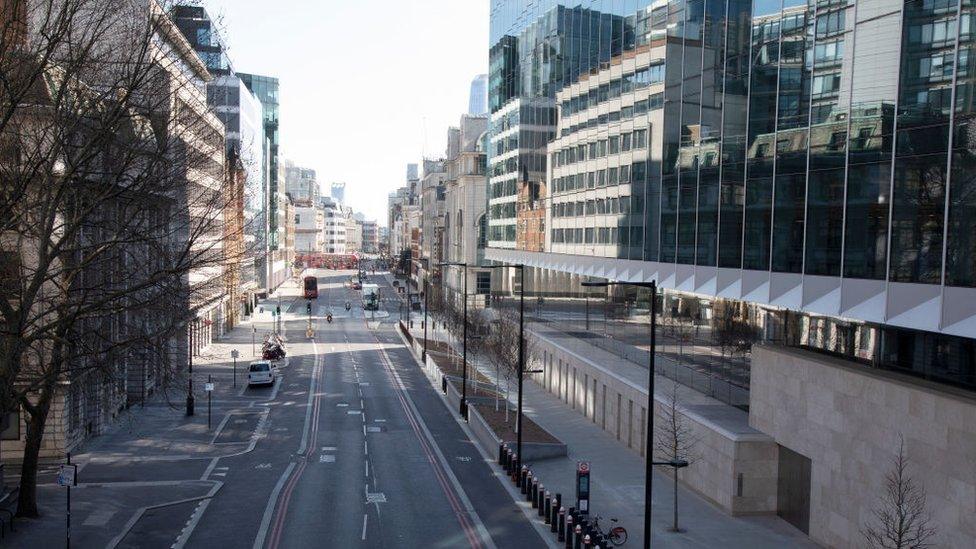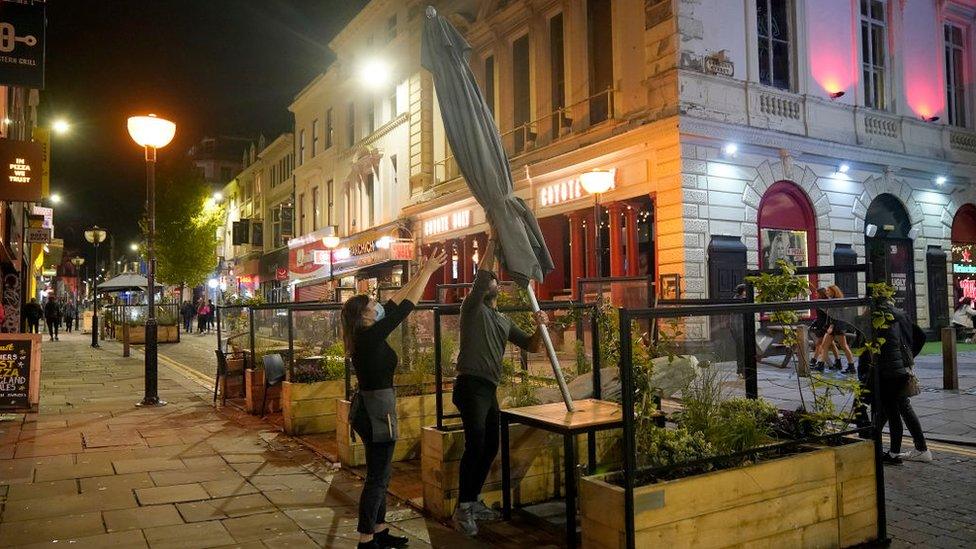Covid: Two-week circuit breaker 'may halve deaths', report says
- Published
- comments

A deserted street in London at the height of lockdown in March
A two-week circuit breaker at the end of October may halve Covid deaths in the UK between now and the end of the year, says a scientific report.
A circuit breaker would see tighter restrictions on lives, possibly similar to the original lockdown.
The researchers said this "buys more time to put other controls in place" and could relieve pressure on the NHS, but there is huge uncertainty.
The idea also needs balancing against the impact on the economy and society.
The point of a mini-lockdown, or circuit breaker, is to break transmission of the virus by introducing a fixed period of strict measures that stop us mixing with other people.
Instead of the epidemic powering ahead, it would be thrown into reverse. The Scientific Advisory Group for Emergencies (Sage) estimates it could rewind the clock by 28 days.
However, Prof Graham Medley, who is a member of Sage and one of the report's authors, warned we may have already "missed the boat" for a planned mini-lockdown at half-term.
He said: "The whole point of these [circuit breakers] is that you do them before you have to.
"I think we are in a position at the moment whereby things are becoming slightly more urgent than where you would use these precautionary breaks."
He told me "you don't need to be a rocket scientist" to realise we are heading for "the majority of people living under much more severe restrictions".

A bar in Liverpool prepares to close under new strict tier three restrictions
This scientific paper, seen by the BBC, is not yet publicly available and has not been reviewed by scientists.
The unpublished mathematical models attempt to calculate how locking down between 24 October and 7 November would change the course of the epidemic. This would coincide with school half terms.
However, the work by the University of Warwick and the London School of Hygiene and Tropical Medicine is not a crystal ball, there is large uncertainty and some of the predictions would never happen in the real world.
How many lives could be saved?
It says deaths could be reduced by between 29% and 49%, but this will depend on the trajectory of the epidemic. The faster the virus spreads this winter, the more effective a circuit breaker now would be.
They also run the numbers on a range of options similar to the full lockdown in April and May through to the milder restrictions in place in June.
The number of lives saved between now and the start of 2021 could range from 800 (pandemic grows slowly, mild restrictions used) to 106,000 (pandemic grows rapidly and severe restrictions used).
However, the highest numbers are highly unlikely to happen, say the researchers.
"There would be other action before deaths got to those numbers," Dr Michael Tildesley, one of the report's authors from the University of Warwick, told me.

An illustration, not a prediction, of what could happen if the current growth rate continues unchanged, with and without a circuit break.
The idea of a circuit breaker was recommended to ministers by Sage on 21 September. It was rejected, but Labour has since backed the idea and tougher measures are being introduced in Northern Ireland.
Prof Matt Keeling, from the University of Warwick and one of the researchers, said the "stricter the restrictions, the greater the impact".
He told the BBC: "We're not advocating any one policy in this paper, we are just looking at a range of things."
Dr Tildesley added: "Overall the results are very common sense.
"The key thing is we would get a decline in cases and similar reductions in hospital admission and mortality.
"We're getting into a period where we know the NHS is facing high demands, so the benefit is protecting the NHS from a wave of admission of Covid cases."

IMMUNITY: Can you catch it twice?
SOCIAL DISTANCING: How have rules on meeting friends changed?
FACE MASKS: When do I need to wear one?
TESTING: How do I get a virus test?

However, a circuit breaker buys only time, it does not solve the problem
"To save lives over longer time scales requires driving R below one," the group says.
R is the number of people each infected person passes the virus onto, on average. Anything over 1.0 means the epidemic is growing.
The government's Test and Trace programme is not coping with the current number of infections. One possibility is a circuit breaker buys the time to get the programme working effectively again.
Another possibility is it would take multiple circuit breakers to see us through winter.
The scientists warn there are three things that must be considered as part of any discussion of a circuit breaker:
What are the harms to the economy and society?
Will people support and abide by more tight controls?
What happens next to ensure we do not return to the same situation?
Follow James on Twitter, external

LIVING WITH BULIMIA: Freddie Flintoff goes on a personal journey
YOUNG PEOPLE AND MENTAL HEALTH: Mimi is on a mission